Size Distribution and Variation in Surface-Suspended Sediments in the North Passage Estuarine Turbidity Maximum of the Yangtze Estuary
Abstract
1. Introduction
2. Methodology and General Conditions of the Study Area
2.1. Study Area
2.2. Methodology and Data Processing
3. Results
3.1. Hydrological and Hydrodynamic Conditions of the North Passage of Yangtze Estuary
3.2. Surface-Suspended Sediment
3.3. Surface Particle Sizes (SPS)
3.4. Surface-Suspended Sediment Concentration
3.5. Surface Particle Size
4. Discussion
4.1. Correlations of Hydrological Conditions with SSC and D50
4.2. Surface-Suspended Sediment
4.3. Surface Particle Sizes
4.4. Tidal Inputs on SSSC and SPS
5. Conclusions
Author Contributions
Funding
Data Availability Statement
Conflicts of Interest
Appendix A

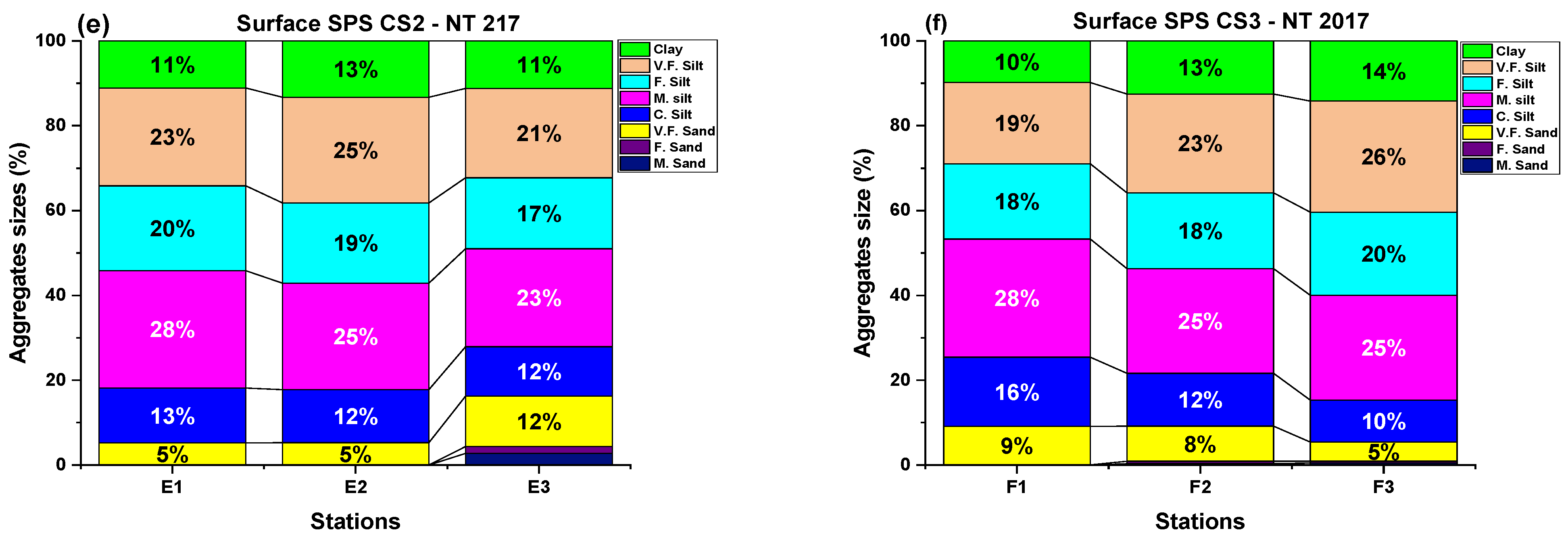
| Stations | Av. Surface SSC 2016 (Kgm−3) Spring Tides | STD | Av. Surface SSC 2016 (Kgm−3) Neap Tides | STD |
|---|---|---|---|---|
| A | 0.11 | 0.047 | 0.08 | 0.03 |
| B | 0.11 | 0.054 | 0.09 | 0.01 |
| C | 0.13 | 0.055 | 0.08 | 0.04 |
| D | 0.24 | 0.135 | 0.11 | 0.06 |
| E | 0.19 | 0.138 | 0.09 | 0.05 |
| F | 0.21 | 0.153 | 0.10 | 0.07 |
| G | 0.16 | 0.096 | 0.07 | 0.03 |
| H | 0.14 | 0.093 | 0.05 | 0.02 |
| I | 0.13 | 0.14 | 0.01 | 0.01 |
| CS1 | ||||
| D1 | 0.25 | 0.135 | 0.11 | 0.062 |
| D2 | 0.16 | 0.061 | 0.12 | 0.053 |
| D3 | 0.18 | 0.102 | 0.11 | 0.064 |
| CS2 | ||||
| E1 | 0.2 | 0.138 | 0.09 | 0.051 |
| E2 | 0.23 | 0.125 | 0.11 | 0.032 |
| E3 | 0.18 | 0.089 | 0.09 | 0.042 |
| CS3 | ||||
| F1 | 0.2 | 0.153 | 0.1 | 0.077 |
| F2 | 0.22 | 0.125 | 0.11 | 0.072 |
| F3 | 0.24 | 0.232 | 0.1 | 0.077 |
| Stations | Av. Surface SSC 2017 (Kgm−3) Summer-Spring Tides | STD | Av. Surface SSC 2017 (Kgm−3) Summer-Neap Tides | STD |
|---|---|---|---|---|
| A | 0.14 | 0.05 | 0.06 | 0.01 |
| B | 0.12 | 0.04 | 0.09 | 0.01 |
| C | 0.05 | 0.07 | 0.07 | 0.09 |
| D | 0.20 | 0.07 | 0.04 | 0.02 |
| E | 0.24 | 0.09 | 0.11 | 0.03 |
| F | 0.18 | 0.09 | 0.05 | 0.03 |
| G | 0.16 | 0.09 | 0.05 | 0.02 |
| H | 0.15 | 0.08 | 0.05 | 0.02 |
| I | 0.14 | 0.05 | 0.04 | 0.02 |
| CS1 | ||||
| D1 | 0.2 | 0.076 | 0.39 | 0.024 |
| D2 | 0.36 | 0.143 | 0.118 | 0.066 |
| D3 | 0.19 | 0.073 | 0.121 | 0.043 |
| CS2 | ||||
| E1 | 0.23 | 0.1 | 0.11 | 0.035 |
| E2 | 0.19 | 0.07 | 0.06 | 0.034 |
| E3 | 0.18 | 0.06 | 0.08 | 0.03 |
| CS3 | ||||
| F1 | 0.176 | 0.09 | 0.05 | 0.03 |
| F2 | 0.23 | 0.095 | 0.08 | 0.04 |
| F3 | 0.206 | 0.26 | 0.07 | 0.07 |
| Stations | Av. Surface SSC 2017 (Kgm−3) Winter-Spring Tides | STD | Av. Surface SSC 2017 (Kgm−3) Winter-Neap Tides | STD |
|---|---|---|---|---|
| A | 0.26 | 0.11 | 0.04 | 0.02 |
| B | 0.20 | 0.11 | 0.05 | 0.02 |
| C | 0.25 | 0.18 | 0.04 | 0.007 |
| D | 0.34 | 0.16 | 0.05 | 0.013 |
| E | 0.22 | 0.11 | 0.03 | 0.012 |
| F | 0.31 | 0.17 | 0.03 | 0.014 |
| G | 0.27 | 0.16 | 0.04 | 0.015 |
| H | 0.10 | 0.07 | 0.08 | 0.011 |
| I | 0.31 | 0.11 | 0.10 | 0.045 |
| Stations | Averaged Surface SSC (Kgm−3) Summer-Spring Tides 2018 | STD | Averaged Surface SSC (Kgm−3) Summer-Neap Tides 2018 | STD |
|---|---|---|---|---|
| A | 0.25 | 0.12 | 0.12 | 0.02 |
| B | 0.22 | 0.067 | 0.11 | 0.028 |
| C | 0.27 | 0.12 | 0.11 | 0.04 |
| D | 0.21 | 0.09 | 0.12 | 0.036 |
| E | 0.20 | 0.11 | 0.07 | 0.024 |
| F | 0.27 | 0.12 | 0.08 | 0.024 |
| G | 0.23 | 0.13 | 0.08 | 0.025 |
| H | 0.40 | 0.38 | 0.07 | 0.023 |
| I | 0.12 | 0.05 | 0.06 | 0.02 |
| Stations | Averaged Surface SSC 2018 (Kgm−3) Winter-Spring Tides | STD | Averaged Surface SSC 2018 (Kgm−3) Winter-Neap Tides | STD |
|---|---|---|---|---|
| A | 0.26 | 0.128 | 0.14 | 0.038 |
| B | 0.14 | 0.06 | 0.09 | 0.03 |
| C | 0.21 | 0.10 | 0.08 | 0.032 |
| D | 0.36 | 0.24 | 0.07 | 0.031 |
| E | 0.37 | 0.31 | 0.14 | 0.015 |
| F | 0.25 | 0.19 | 0.07 | 0.028 |
| G | 0.18 | 0.11 | 0.05 | 0.032 |
| H | 0.24 | 0.11 | 0.07 | 0.033 |
| I | 0.22 | 0.11 | 0.06 | 0.033 |
| Stations | Averaged Surface D50 (µm) 2016 Spring Tides | STD | Averaged Surface D50 (µm) 2016 Neap Tides | STD |
|---|---|---|---|---|
| A | 10 | 1.2 | 9 | 1.5 |
| B | 10 | 1.1 | 9 | 1.2 |
| C | 7 | 2.2 | 9 | 1.7 |
| D | 9 | 1.6 | 9 | 1.6 |
| E | 9 | 2.3 | 8 | 1.3 |
| F | 8 | 1 | 7 | 0.9 |
| G | 10 | 3.1 | 8 | 1.8 |
| H | 9 | 2 | 8 | 1.7 |
| I | 7 | 0.7 | 12 | 1.7 |
| CS1 | ||||
| D1 | 9 | 1.6 | 9 | 1.6 |
| D2 | 11 | 2.1 | 9 | 2.7 |
| D3 | 10 | 2 | 8 | 1.1 |
| CS2 | ||||
| E1 | 9 | 2.3 | 8 | 1.3 |
| E2 | 8 | 1.2 | 8 | 0.7 |
| E3 | 9 | 1.8 | 9 | 1.2 |
| CS3 | ||||
| F1 | 8 | 1 | 7 | 0.9 |
| F2 | 10 | 1.3 | 7 | 0.8 |
| F3 | 8 | 1.5 | 8 | 0.9 |
| Stations | Averaged Surface D50 (µm) 2017 Spring Tides | STD | Averaged Surface D50 (µm) 2017 Neap Tides | STD |
|---|---|---|---|---|
| A | 7 | 1.2 | 10.5 | 1.2 |
| B | 10.1 | 1.2 | 5.1 | 1 |
| C | 7.4 | 2.2 | 8.8 | 1 |
| D | 10.3 | 2.5 | 9.3 | 1.3 |
| E | 7.8 | 4 | 7.9 | 0.9 |
| F | 7.1 | 1.6 | 10.8 | 1.8 |
| G | 7 | 1.8 | 4.6 | 0.5 |
| H | 6 | 1.3 | 8.4 | 1.2 |
| I | 6.1 | 0.6 | 6 | 0.9 |
| CS1 | ||||
| D1 | 6.4 | 2.5 | 8.5 | 1.3 |
| D2 | 8.1 | 1.8 | 6.8 | 1.1 |
| D3 | 5.4 | 1.5 | 7.7 | 1.2 |
| CS2 | ||||
| E1 | 7.4 | 4 | 7.3 | 0.9 |
| E2 | 8.3 | 1.1 | 6.9 | 1.3 |
| E3 | 6.7 | 1.8 | 8.3 | 1 |
| CS3 | ||||
| F1 | 4.8 | 1.6 | 8.7 | 1.8 |
| F2 | 4.5 | 2.7 | 7.4 | 1.7 |
| F3 | 8.7 | 1.7 | 4.9 | 1 |
References
- Latrubesse, E.M.; Park, E.; Lim, J. Geomorphology and Suspended Sediment Transport of the Second Largest River of Southeast Asia: The Irrawaddy River, Myanmar. In AGU Fall Meeting Abstracts; AA (Nanyang Technological University): Singapore; AB (University of Texas at Austin): Austin, TX, USA; AC (Nanyang Technological University): Singapore, 2019; Volume 2019, p. EP51E-2120. Available online: https://ui.adsabs.harvard.edu/abs/2019AGUFMEP51E2120L (accessed on 1 December 2023).
- ywater-Reyes, S.; Segura, C.; Bladon, K.D. Geology and geomorphology control suspended sediment yield and modulate increases following timber harvest in temperate headwater streams. J. Hydrol. 2017, 548, 754–769. [Google Scholar] [CrossRef]
- Chu, A. Analysis and Modelling of Morphodynamics of the Yangtze Estuary; Delft University of Technology: Delft, The Netherlands, 2019. [Google Scholar]
- Rodgers, K.; McLellan, I.; Peshkur, T.; Williams, R.; Tonner, R.; Knapp, C.W.; Henriquez, F.L.; Hursthouse, A.S. The legacy of industrial pollution in estuarine sediments: Spatial and temporal variability implications for ecosystem stress. Environ. Geochem. Health 2019, 42, 1057–1068. [Google Scholar] [CrossRef] [PubMed]
- Zhang, W.; Xu, Y.J.; Guo, L.; Lam, N.S.-N.; Xu, K.; Yang, S.; Yao, Q.; Liu, K.-B. Comparing the Yangtze and Mississippi River Deltas in the light of coupled natural-human dynamics: Lessons learned and implications for management. Geomorphology 2022, 399, 108075. [Google Scholar] [CrossRef]
- Yang, H.-B.; Li, E.-C.; Zhao, Y.; Liang, Q.-H. Effect of water-sediment regulation and its impact on coastline and suspended sediment concentration in Yellow River Estuary. Water Sci. Eng. 2017, 10, 311–319. [Google Scholar] [CrossRef]
- Yufang, H.; Chuanteng, L. Process research on estuarine turbidity maximum and mouth bar of Yangtze Estuary after the improvement works. Procedia Eng. 2015, 116, 80–87. [Google Scholar] [CrossRef][Green Version]
- Jie, J.; Qing, H.; Lei, Z.; Lin, J. Analysis of hydrodynamic features of the north passage in the turbidity maximum, Changjiang estuary. Haiyang Xuebao 2019, 41, 11–20. [Google Scholar] [CrossRef]
- Shen, F.; Salama, M.S.; Zhou, Y.-X.; Li, J.-F.; Su, Z.; Kuang, D.-B. Remote-sensing reflectance characteristics of highly turbid estuarine waters—A comparative experiment of the Yangtze River and the Yellow River. Int. J. Remote Sens. 2010, 31, 2639–2654. [Google Scholar] [CrossRef]
- Song, D.; Dong, Y.; Bao, X. Spring-neap tidal variation and mechanism analysis of the maximum turbidity in the Pearl River Estuary during flood season. J. Trop. Oceanogr. 2020, 39, 20–35. Available online: https://www.sciengine.com/JTO/doi/10.11978/2019035;JSESSIONID=7878deba-6c18-4eed-9798-3e4907955e88 (accessed on 1 December 2023).
- Boyd, C.E. Particulate Matter, Turbidity, and Color BT—Water Quality: An Introduction; Boyd, C.E., Ed.; Springer: Boston, MA, USA, 2000; pp. 95–103. [Google Scholar] [CrossRef]
- Xu, F.; Yao, J.; Tao, J.F.; Yang, T. Effect of Large Scale Tidal Flat Reclamation on Hydrodynamic Circulation in Jiangsu Coastal Areas. In Asian and Pacific Coasts; 2011; pp. 662–669. Available online: https://www.worldscientific.com/doi/abs/10.1142/9789814366489_0077%20heart%201 (accessed on 1 December 2023).
- Chen, X.Q.; Yan, Y.X.; Dou, X.P. Preliminary Analysis of the Effects on the Yangtze Estuary After Three-Gorge Project Operation. In Proceedings of the 6th International Conference on APAC 2011, Asian and Pacific Coasts, Hong Kong, 14–16 December 2011. [Google Scholar]
- Wilson, P.C. Water Quality Notes: Water Clarity (Turbidity Suspended Solids and Color) 1. Dep. Soil Water Ecosyst. Sci. 2013, SL314, 1–8. Available online: https://web.archive.org/web/20200709172438/https://edis.ifas.ufl.edu/pdffiles/SS/SS52600.pdf (accessed on 1 December 2023).
- Shen, F.; Verhoef, W.; Zhou, Y.; Salama, M.S.; Liu, X. Satellite Estimates of Wide-Range Suspended Sediment Concentrations in Changjiang (Yangtze) Estuary Using MERIS Data. Estuaries Coasts 2010, 33, 1420–1429. [Google Scholar] [CrossRef]
- Chen, H.; Zhang, J.; Wang, S.; Sun, D.; Qiu, Z. Study on diurnal variation of turbidity in the Yangtze Estuary and adjacent areas by remote sensing. Acta Opt. Sin. 2020, 40, 501003. [Google Scholar] [CrossRef]
- Wang, C.; Wang, D.; Yang, J.; Fu, S.; Li, D. Suspended Sediment within Estuaries and along Coasts: A Review of Spatial and Temporal Variations based on Remote Sensing. J. Coast. Res. 2020, 36, 1323–1331. [Google Scholar] [CrossRef]
- Wan, Y.; Wang, L. Study on the seasonal estuarine turbidity maximum variations of the Yangtze estuary, China. J. Waterw. Port Coast. Ocean. Eng. 2018, 144, 5018002. [Google Scholar] [CrossRef]
- Xu, H.-J.; Huang, Z.; Bai, Y.-C.; Su, L.-S.; Hong, Y.-C.; Lu, T.-T.; Wang, X. Numerical analysis of sediment deposition in Yangtze river estuary: Insight from conceptual estuary models. Appl. Ocean Res. 2020, 104, 102372. [Google Scholar] [CrossRef]
- Shu, C.; Tan, G.; Lv, Y.; Xu, Q. Field methods of a near-bed suspended sediment experiment in the Yangtze River, China. Arab. J. Geosci. 2020, 13, 1118. [Google Scholar] [CrossRef]
- Yang, H.; Li, B.; Zhang, C.; Qiao, H.; Liu, Y.; Bi, J.; Zhang, Z.; Zhou, F. Recent Spatio-Temporal Variations of Suspended Sediment Concentrations in the Yangtze Estuary. Water 2020, 12, 818. [Google Scholar] [CrossRef]
- Wu, S.; Cheng, H.; Xu, Y.J.; Li, J.; Zheng, S.; Xu, W. Riverbed Micromorphology of the Yangtze River Estuary, China. Water 2016, 8, 190. [Google Scholar] [CrossRef]
- Wu, S.; Cheng, H.; Xu, Y.; Li, J.; Zheng, S. Decadal changes in bathymetry of the Yangtze River Estuary: Human impacts and potential saltwater intrusion. Estuar. Coast. Shelf Sci. 2016, 182, 158–169. [Google Scholar] [CrossRef]
- Tang, M.; Cheng, H.; Xu, Y.; Hu, H.; Zheng, S.; Wang, B.; Yang, Z.; Teng, L.; Xu, W.; Zhang, E.; et al. Channel Bed Adjustment of the Lowermost Yangtze River Estuary from 1983 to 2018: Causes and Implications. Water 2022, 14, 4135. [Google Scholar] [CrossRef]
- Teng, L.; Cheng, H.; de Swart, H.; Dong, P.; Li, Z.; Li, J.; Wang, Y. On the mechanism behind the shift of the turbidity maximum zone in response to reclamations in the Yangtze (Changjiang) Estuary, China. Mar. Geol. 2021, 440, 106569. [Google Scholar] [CrossRef]
- Silva, A.M.M.; Asp, N.E.; Gomes, V.J.C.; Ogston, A.S. Impacts of Inherited Morphology and Offshore Suspended-Sediment Load in an Amazon Estuary. Estuaries Coasts 2023, 46, 1709–1722. [Google Scholar] [CrossRef]
- Silva, A.M.M.; Glover, H.E.; Josten, M.E.; Gomes, V.J.C.; Ogston, A.S.; Asp, N.E. Implications of a Large River Discharge on the Dynamics of a Tide-Dominated Amazonian Estuary. Water 2023, 15, 849. [Google Scholar] [CrossRef]
- Folk, R.L. A Review of Grain-Size Parameters. Sedimentology 1966, 6, 73–93. [Google Scholar] [CrossRef]
- Guo, L.; Su, N.; Townend, I.; Wang, Z.B.; Zhu, C.; Wang, X.; Zhang, Y.; He, Q. From the headwater to the delta: A synthesis of the basin-scale sediment load regime in the Changjiang River. Earth-Sci. Rev. 2019, 197, 102900. [Google Scholar] [CrossRef]
- Chen, N.; Krom, M.D.; Wu, Y.; Yu, D.; Hong, H. Storm induced estuarine turbidity maxima and controls on nutrient fluxes across river-estuary-coast continuum. Sci. Total. Environ. 2018, 628-629, 1108–1120. [Google Scholar] [CrossRef] [PubMed]
- Peng, T.; Tian, H.; Singh, V.P.; Chen, M.; Liu, J.; Ma, H.; Wang, J. Quantitative assessment of drivers of sediment load reduction in the Yangtze River basin, China. J. Hydrol. 2020, 580, 124242. [Google Scholar] [CrossRef]
- Zhu, C.; Zhang, Y.; van Maren, D.S.; Xie, W.; Guo, L.; Wang, X.; He, Q. Modulation of sediment load recovery downstream of Three Gorges Dam in the Yangtze River. Anthr. Coasts 2023, 6, 2. [Google Scholar] [CrossRef]
- Wang, C.; Wang, H.; Song, G.; Zheng, M. Grain size of surface sediments in Selin Co (central Tibet) linked to water depth and offshore distance. J. Paleolimnol. 2019, 61, 217–229. [Google Scholar] [CrossRef]
- Fang, D.; Sun, H.; Peng, Y.; Kuang, Z.; Zhou, Y.; Xu, D. Living Status and Perspective of the Silver Carp (Hypophthalmichthys molitrix) in the Lower Reach of the Yangtze River: Insights from Population Distribution, Age Structure, and Habitat Preference Analyses. Fishes 2022, 7, 254. [Google Scholar] [CrossRef]
- Strickland, J.D.H.; Parsons, T.R. A Practical Handbook of Seawater Analysis; Fisheries Research Board of Canada: Ottawa, ON, Canada, 1972. [Google Scholar]
- Li, W.; Jiang, C.; Zuo, S.; Li, J. Human Intervention–Induced Changes in the Characteristics of the Turbidity Maximum Zone and Associated Mouth Bars in the Yangtze Estuary. J. Mar. Sci. Eng. 2022, 10, 584. [Google Scholar] [CrossRef]
- Li, W.; Li, M.; Zhang, X.; Li, J. Characteristics of fluid mud in the Yangtze Estuary: Storm, tide, and slope-triggered sediment dynamics and effects. Estuar. Coast. Shelf Sci. 2023, 281. [Google Scholar] [CrossRef]
- Chen, J. ADP-flow velocity profile to interpret hydromorphological features of China’s Yangtze Three-Gorges valley. Chin. Sci. Bull. 2005, 50, 679. [Google Scholar] [CrossRef]
- Chen, J.Y.; Shen, H.T.; Yun, C.X. Dynamic Processes and Morphological Evolution of the Changjiang Estuary; Shanghai Science and Technology Press: Shanghai, China, 1988. [Google Scholar]
- Huang, Y.-G.; Yang, H.-F.; Jia, J.-J.; Li, P.; Zhang, W.-X.; Wang, Y.P.; Ding, Y.-F.; Dai, Z.-J.; Shi, B.-W.; Yang, S.-L. Declines in suspended sediment concentration and their geomorphological and biological impacts in the Yangtze River Estuary and adjacent sea. Estuar. Coast. Shelf Sci. 2022, 265, 107708. [Google Scholar] [CrossRef]
- Fan, H.; Yan, H.; Teng, L.; Liu, R.; Li, Z.; Cheng, H.; Zhang, E. The effects of extreme flood events on the turbidity maximum zone in the Yangtze (Changjiang) Estuary, China. Mar. Geol. 2023, 456, 106993. [Google Scholar] [CrossRef]
- Shepard, F.P. Nomenclature Based on Sand-silt-clay Ratios. J. Sediment. Res. 1954, 24, 151–158. Available online: https://api.semanticscholar.org/CorpusID:129806833 (accessed on 1 December 2023).
- Version, A.F.; Soils, C.O.F.; The, F.O.R.; Dredging, M. WG Report n° 144-2017 Abridged Field Version Classification of Soils and Rocks for the Maritime Dredging Process. 2017. Available online: https://izw.baw.de/publikationen/pianc/0/marcom144.pdf (accessed on 1 December 2023).
- Oladipo, V.O.; Adedoyin, A.D.; Atat, J.G. The Geostatistical Investigation of Grain Size and Heavy Minerals of Stream Sediments from Agunjin Area, Kwara State. World J. Appl. Sci. Technol. 2018, 10, 249–257. [Google Scholar]
- Pareja-Roman, L.F.; Orton, P.M.; Talke, S.A. Effect of Estuary Urbanization on Tidal Dynamics and High Tide Flooding in a Coastal Lagoon. J. Geophys. Res. Oceans 2023, 128, e2022JC018777. [Google Scholar] [CrossRef]
- Sohrt, V.; Hein, S.S.; Nehlsen, E.; Strotmann, T.; Fröhle, P. Model Based Assessment of the Reflection Behavior of Tidal Waves at Bathymetric Changes in Estuaries. Water 2021, 13, 489. [Google Scholar] [CrossRef]
- Fivash, G.S.; Temmerman, S.; Kleinhans, M.G.; Heuner, M.; van der Heide, T.; Bouma, T.J. Early indicators of tidal ecosystem shifts in estuaries. Nat. Commun. 2023, 14, 1911. [Google Scholar] [CrossRef]
- Wang, H.; Jia, Y.; Ji, C.; Jiang, W.; Bian, C. Internal tide-induced turbulent mixing and suspended sediment transport at the bottom boundary layer of the South China Sea slope. J. Mar. Syst. 2022, 230, 103723. [Google Scholar] [CrossRef]
- Xing, F.; Wang, Y.P.; Jia, J. Hydrodynamics and sediment transport patterns on intertidal flats along middle Jiangsu coast. Anthr. Coasts 2022, 5, 1–19. [Google Scholar] [CrossRef]
- Huang, J.; Zhu, J. Suspended sediment dynamics and influencing factors during typhoons in Hangzhou Bay, China. Anthr. Coasts 2023, 6, 3. [Google Scholar] [CrossRef]
- Essink, K. Ecological effects of dumping of dredged sediments; options for management. J. Coast. Conserv. 1999, 5, 69–80. [Google Scholar] [CrossRef]
- Li, Z.; Wang, Y.; Cheng, P.; Zhang, G.; Li, J. Flood-ebb asymmetry in current velocity and suspended sediment transport in the Changjiang Estuary. Acta Oceanol. Sin. 2016, 35, 37–47. [Google Scholar] [CrossRef]
- Xiao, C.; Zhu, X.-H.; Zhang, C.; Zhu, Z.-N.; Ma, Y.L.; Zhong, J.W.; Wei, L.X. Coastal acoustic tomography system for monitoring transect suspended sediment discharge of Yangtze river. J. Hydrol. 2023, 623, 129832. [Google Scholar] [CrossRef]
- Wolanski, E.; Gibbs, R.J.; Mazda, Y.; Mehta, A.; King, B. The Role of Turbulence in the Settling of Mud Flocs. J. Coast. Res. 1992, 8, 35–46. Available online: http://www.jstor.org/stable/4297950 (accessed on 1 December 2023).
- Zhu, C.; van Maren, D.S.; Guo, L.; Lin, J.; He, Q.; Wang, Z.B. Effects of Sediment-Induced Density Gradients on the Estuarine Turbidity Maximum in the Yangtze Estuary. J. Geophys. Res. Oceans 2021, 126, e2020JC016927. [Google Scholar] [CrossRef]
- Vinh, V.D.; Ouillon, S.; Van Uu, D. Estuarine Turbidity Maxima and Variations of Aggregate Parameters in the Cam-Nam Trieu Estuary, North Vietnam, in Early Wet Season. Water 2018, 10, 68. [Google Scholar] [CrossRef]
- Yang, Z.F.; Chen, D.; Xiao, B.P. Impact assessment of dredging on fish eggs and larvae: A case study in Caotan, South China. IOP Conf. Ser. Earth Environ. Sci. 2019, 351, 012035. [Google Scholar] [CrossRef]
- Zhang, Y.; Ren, J.; Zhang, W.; Wu, J. Importance of salinity-induced stratification on flocculation in tidal estuaries. J. Hydrol. 2021, 596, 126063. [Google Scholar] [CrossRef]
- Teng, L.; Cheng, H.; Zhang, E.; Wang, Y. Lateral Variation of Tidal Mixing Asymmetry and Its Impact on the Longitudinal Sediment Transport in Turbidity Maximum Zone of Salt Wedge Estuary. J. Mar. Sci. Eng. 2022, 10, 907. [Google Scholar] [CrossRef]
- Allen, R.M.; Lacy, J.R.; Stacey, M.T.; Variano, E.V. Seasonal, Spring-Neap, and Tidal Variation in Cohesive Sediment Transport Parameters in Estuarine Shallows. J. Geophys. Res. Ocean. 2019, 124, 7265–7284. [Google Scholar] [CrossRef]
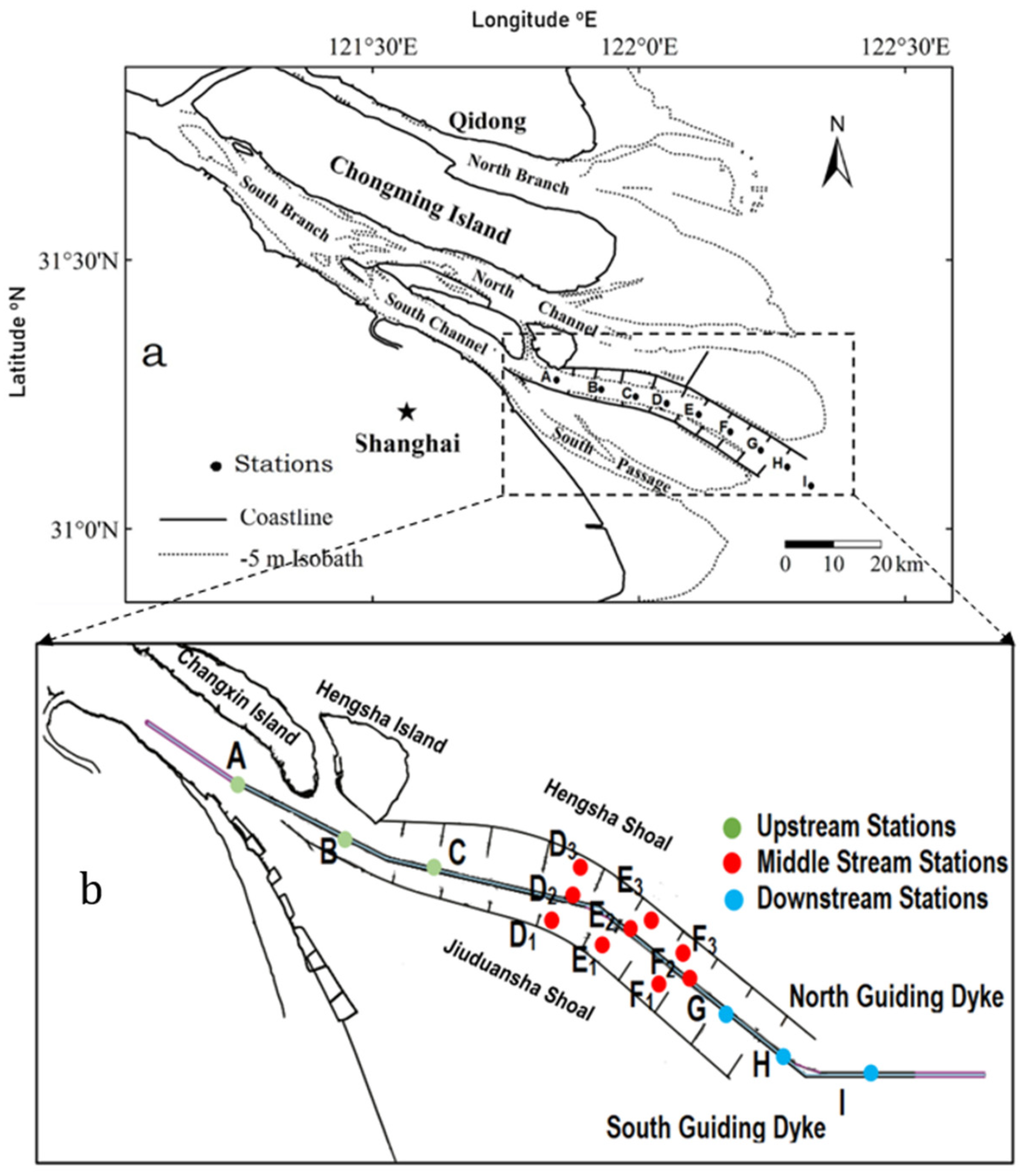

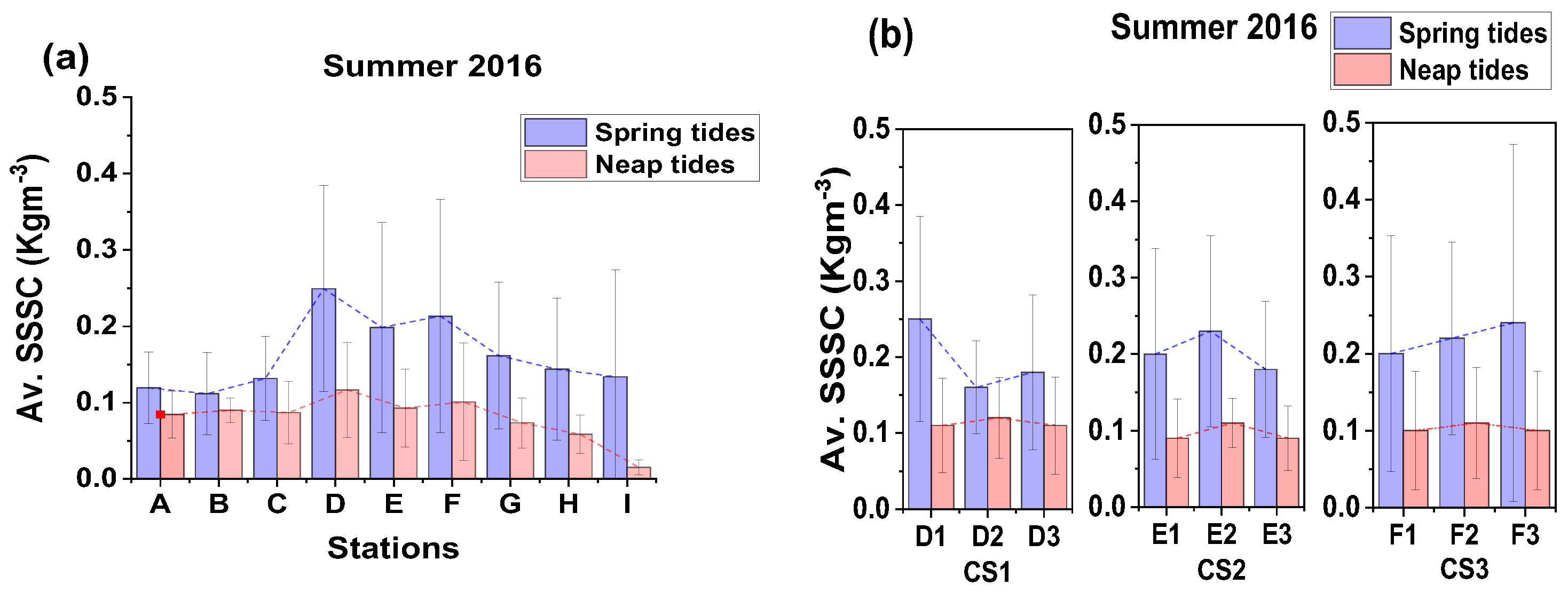
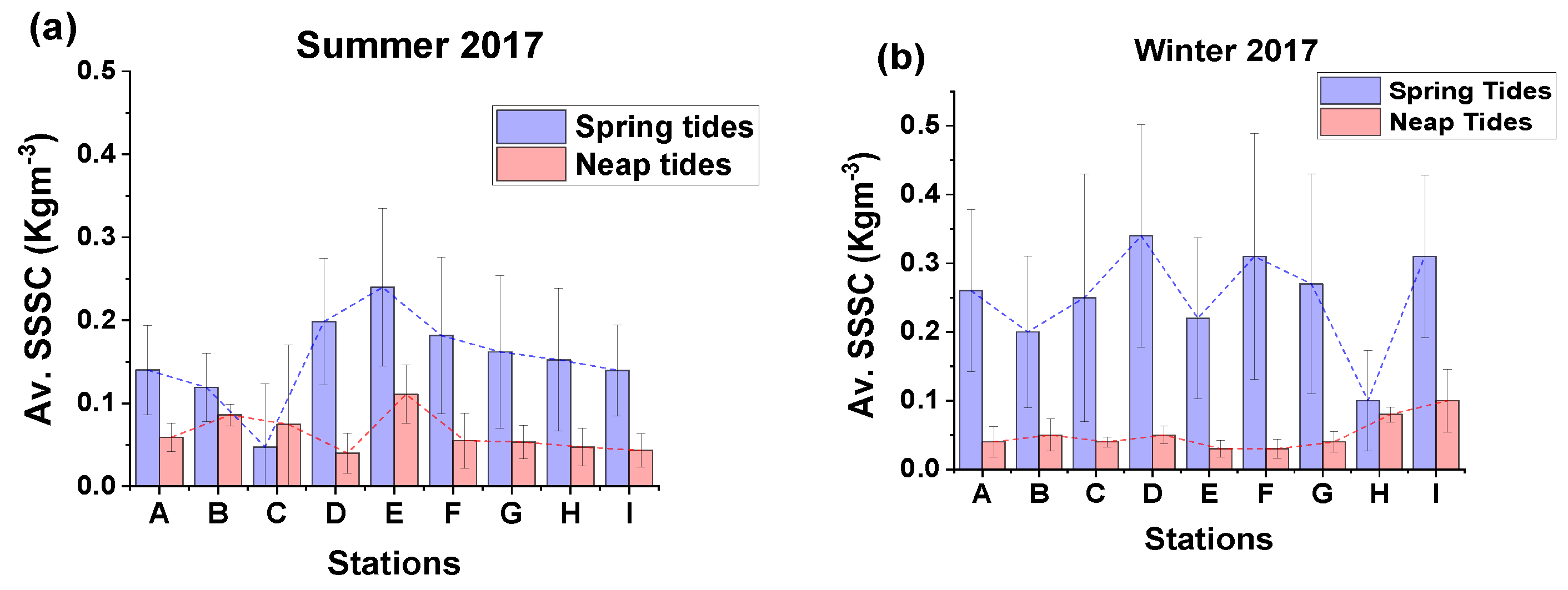


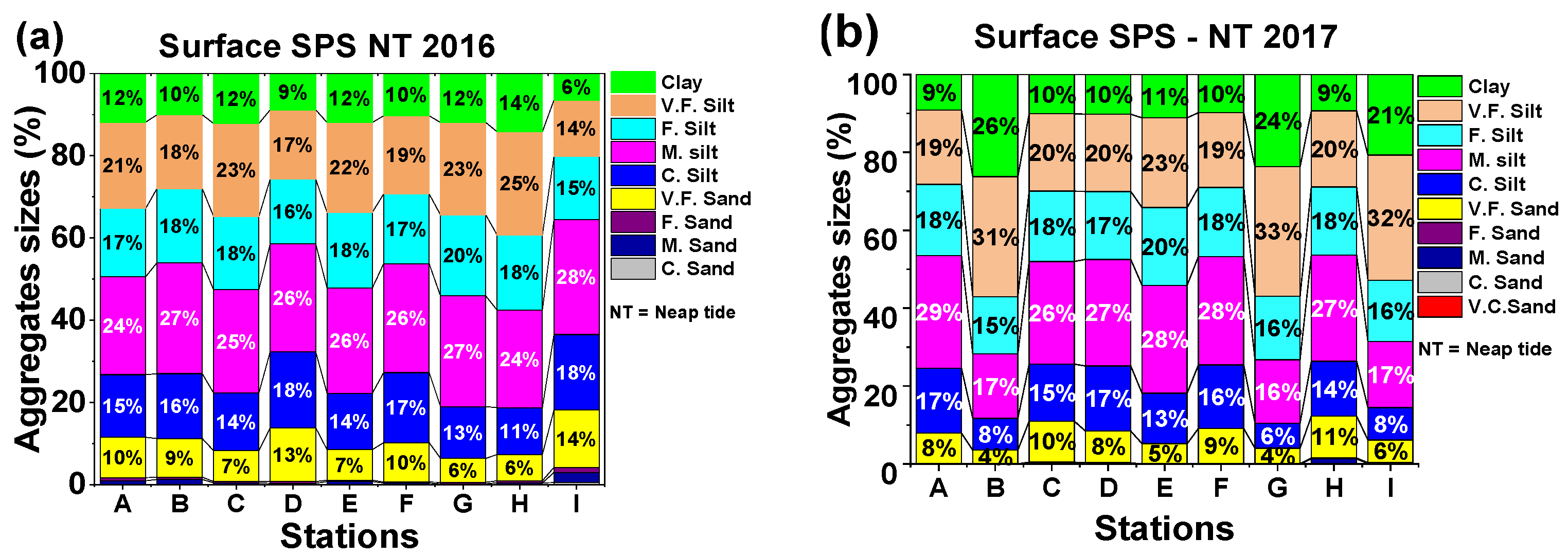




| Spring Tides | Neap Tides | ||||
|---|---|---|---|---|---|
| Start | End | Start | End | ||
| Summer | 2016 | 21 July at 7 a.m. | 22 July at 11 a.m. | 27 July at 10 a.m. | 28 July at 9 p.m. |
| 2017 | 10 July at 7 p.m. | 11 July at 11 p.m. | 18 July at 12 noon | 19 July at 7 p.m. | |
| 2018 | 14 August at 6 a.m. | 15 August at 11 a.m. | 6 August at 11 a.m. | 7 August at 5 p.m. | |
| Winter | 2017 | 28 February at 7 p.m. | 02 March at 00 p.m. | 21 February at 12 noon | 22nd February at 9 p.m. |
| 2018 | 30 January at 4 p.m. | 31st January at 10 p.m. | 8 February at 5 p.m. | 9 February at 10 p.m. | |
Disclaimer/Publisher’s Note: The statements, opinions and data contained in all publications are solely those of the individual author(s) and contributor(s) and not of MDPI and/or the editor(s). MDPI and/or the editor(s) disclaim responsibility for any injury to people or property resulting from any ideas, methods, instructions or products referred to in the content. |
© 2024 by the authors. Licensee MDPI, Basel, Switzerland. This article is an open access article distributed under the terms and conditions of the Creative Commons Attribution (CC BY) license (https://creativecommons.org/licenses/by/4.0/).
Share and Cite
Assam, S.L.Z.; Chen, Y.; Chu, A.; Okon, S.U.; Anteilla L. M., G.; Eyezo’o, G.Z. Size Distribution and Variation in Surface-Suspended Sediments in the North Passage Estuarine Turbidity Maximum of the Yangtze Estuary. Water 2024, 16, 306. https://doi.org/10.3390/w16020306
Assam SLZ, Chen Y, Chu A, Okon SU, Anteilla L. M. G, Eyezo’o GZ. Size Distribution and Variation in Surface-Suspended Sediments in the North Passage Estuarine Turbidity Maximum of the Yangtze Estuary. Water. 2024; 16(2):306. https://doi.org/10.3390/w16020306
Chicago/Turabian StyleAssam, Steve L. Zeh, Yongping Chen, Ao Chu, Samuel Ukpong Okon, Genide Anteilla L. M., and Giresse Ze Eyezo’o. 2024. "Size Distribution and Variation in Surface-Suspended Sediments in the North Passage Estuarine Turbidity Maximum of the Yangtze Estuary" Water 16, no. 2: 306. https://doi.org/10.3390/w16020306
APA StyleAssam, S. L. Z., Chen, Y., Chu, A., Okon, S. U., Anteilla L. M., G., & Eyezo’o, G. Z. (2024). Size Distribution and Variation in Surface-Suspended Sediments in the North Passage Estuarine Turbidity Maximum of the Yangtze Estuary. Water, 16(2), 306. https://doi.org/10.3390/w16020306







